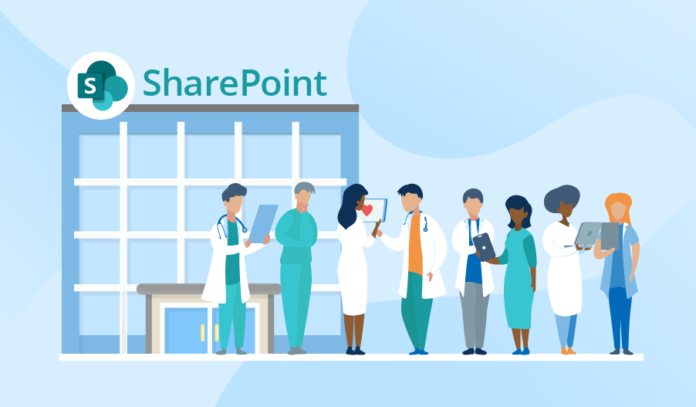The healthcare industry handles highly sensitive data and has complex workflows. From managing patient records to coordinating care teams, healthcare organizations deal with diverse processes. Without the right tools, these can become inefficient, leading to compromised patient care.
This is where SharePoint steps in.
In this guide, we’ll explore how SharePoint helps healthcare organizations like yours boost productivity, enhance collaboration, and deliver improved patient outcomes.
The Core Problems in Healthcare
Before diving into the SharePoint solution, let’s look at some of the core problems faced by healthcare organizations:
Limited Collaboration and Communication
Healthcare involves many parties – doctors, nurses, lab technicians, pharmacists, administrators, etc. Lack of real-time communication and seamless collaboration between them can severely impact patient care. Vital information might be missed or delayed.
Inefficient Data Management and Compliance
Healthcare organizations handle vast amounts of data from patient records to billing information. The lack of a centralized document management system makes it difficult to store, track, and share files securely. This also poses compliance risks with regulations like HIPAA.
Lack of Intranet and Extranet Solutions
Many healthcare providers lack robust intranet and extranet portals. This hampers internal communication and knowledge sharing. It also makes it tough to collaborate smoothly with external partners like pharmaceutical companies and insurance providers.
The Worst-Case Scenarios
Without proper tools to address these challenges, healthcare organizations can face severe consequences including:
- Compromised patient safety due to ineffective emergency coordination between doctors and nurses
- Huge financial penalties and loss of patient trust due to data breaches
- Workflow disruptions and operational inefficiencies due to lack of smooth communication between departments, vendors, insurance companies, etc.
This is where SharePoint makes all the difference.
How SharePoint Helps Healthcare Organizations
SharePoint is Microsoft’s popular collaboration and process management platform. With robust features, it is a versatile solution for common healthcare industry challenges.
Here are some ways SharePoint helps healthcare organizations:
Centralized Document Management
SharePoint is a centralized document repository for patient records, lab reports, treatment plans, and more. The built-in security features and permission management allow controlling access to confidential data.
With version history, document tagging, and metadata-based search, finding the right files is easy for authorized users.
Seamless Collaboration
SharePoint streamlines communication and collaboration across the organizational hierarchy. Doctors can discuss treatment plans, nurses can share shift schedules, and administrators can manage projects – all through SharePoint.
This improves productivity and decision-making. Features like shared calendars, wikis, task lists, and discussion boards foster seamless collaboration.
Secure Information Sharing
Robust permission management and access controls make SharePoint ideal for secure information sharing in healthcare. Admins can allow only authorized personnel to access confidential data like patient records.
This boosts information sharing while also adhering to HIPAA and other healthcare data regulations.
Streamlined Processes
From patient onboarding to billing, healthcare involves many complex processes. SharePoint helps create automated workflows to streamline these processes.
For instance, discharge forms can automatically route for approval. Appointment booking can trigger SMS confirmations. This reduces manual efforts and errors.
Enhanced Intranet and Extranet
With SharePoint, creating intranet and extranet portals for healthcare is easy. These improve communication and collaboration internally between employees as well as externally with partners.
An intranet portal can act as a staff knowledge hub while an extranet site can help manage hospital-supplier relationships seamlessly.
analytics and reporting on KPIs through seamless integration with Power BI dashboards. These data-driven insights help identify opportunities for process improvements.
Optimized Patient Portals
SharePoint helps create personalized self-service patient portals for appointment booking, bill payments, prescription refills, and telehealth consultations.
This leads to superior patient engagement. Integrations with Azure Machine Learning can also provide AI-powered symptom checkers and virtual health assistants.
The Benefits of SharePoint for Healthcare
By leveraging SharePoint’s diverse capabilities, healthcare organizations can:
- Improve staff communication and knowledge sharing through intranets
- Securely share and manage patient data with total compliance
- Automate complex workflows to boost efficiency
- Facilitate care coordination by connecting health teams on a common platform
- Provide top-notch patient portals for engagement and self-service
- Unlock data insights to identify opportunities for process optimization
In essence, SharePoint helps unlock productivity, enhance compliance, improve care quality, and elevate patient satisfaction.
Key Components of a SharePoint Solution
For maximum impact, SharePoint solutions for healthcare are built using these essential components:
- Document management libraries to store and organize files like patient records, lab reports, etc.
- Custom lists and forms to digitize data capture like patient intake forms
- Wikis and discussion boards for collaboration across teams
- Workflows to automate processes like discharge approval procedures
- Dashboards that pull in data from EHRs, scheduling software, billing systems, etc. using Power BI
- Custom brand themes that reflect the healthcare provider’s visual identity
- Permission management to securely restrict access to confidential data
- Patient portals with self-service functionality and telehealth features
- Integrations with key healthcare IT systems like EHR software, medical devices, etc.
How SharePoint Delivers Value
Now let’s understand how SharePoint brings specific value across healthcare organizations:
For Nurses
- Access centralized knowledge base and protocols
- Coordinate and communicate with cross-functional teams
- Manage tasks, to-do lists, and schedules
- Share updates through department sites and wikis
For Doctors
- Securely store and find patient records instantly
- Collaborate with colleagues and coordinate care delivery
- Share expertise through knowledge wikis
- Discuss treatment plans and patient updates
For Administrative Staff
- Streamline routine processes through workflows
- Manage employee records and training materials
- Coordinate with external partners using extranet sites
- Bring in data from across systems through integrations
For Healthcare IT Teams
- Flexibility to build customized solutions
- A unified platform to consolidate disparate systems
- Robust security, compliance, and governance capabilities
- Scalability to support organizational growth
For Patients
- Access health records and test reports securely
- Book appointments, make payments, refill prescriptions
- Connect with care providers through telehealth
- Access knowledge base for health education
Finding the Right SharePoint Provider
To unlock the full potential of SharePoint for your healthcare organization, partnering with the right SharePoint consulting company is key. Here is a checklist to help you find the ideal SharePoint expert:
✔ Look for prior experience in the healthcare domain
✔ Verify their capabilities across the entire SharePoint stack
✔Validate technical expertise around integrations, analytics, security, etc.
✔Evaluate experience in designing intuitive solutions and interfaces
✔Assess capabilities around promoting user adoption post-deployment
✔Verify they have the right certifications and credentials
✔Check client reviews and testimonials
✔Ensure they provide ongoing support and maintenance
✔Find out about pricing models and budgets
This checklist will help you select the right SharePoint consulting partner that can understand your environment and deliver the maximum ROI.
Conclusion
In summary, SharePoint empowers healthcare organizations to boost team collaboration, streamline workflows, enhance compliance and improve patient experience.
With capabilities to develop customized SharePoint solutions tailored to healthcare needs, partners like Beyond Intranet can help you maximize your SharePoint investment.
By taking a planned approach and leveraging the versatile features of SharePoint, healthcare providers can drive greater productivity, deliver top-notch care, and gain a competitive advantage.
You may also like,








